
XXXI Simpósio Brasileiro de Telecomunicações
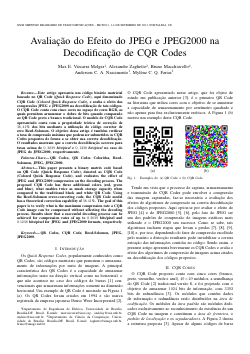
Avaliação do Efeito do JPEG e JPEG2000 na Decodificação de CQR Codes
Max E. Vizcarra Melgar, Alexandre Zaghetto, Bruno Macchiavello, Anderson C. A. Nascimento, Mylène C. Q. Farias
DOI: 10.14209/sbrt.2013.49
Keywords: QR Codes CQR Code Reed-Solomon JPEG JPEG2000
Abstract
This paper presents a binary matrix code based on QR Code (Quick Response Code), denoted as CQR Code (Colored Quick Response Code), and evaluates the effect of JPEG and JPEG2000 compression on the decoding process. The proposed CQR Code has three additional colors (red, green and blue), what enables twice as much storage capacity when compared to the traditional black and white QR Code. Using the Reed-Solomon error-correcting code, the CQR Code model has a theoretical correction capability of 38.41%. The goal of this paper is to verify what is the maximum compression rate a CQR Code image can be compressed without affecting the decoding process. Results show that a successful decoding process can be achieved for compression rates of up to 0.3839bits/pixel and 0.1238bits/pixel for JPEG and JPEG2000 formats, respectively.Download
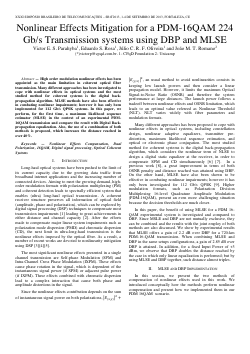
Nonlinear Effects Mitigation for a PDM-16QAM 224 Gb/s Transmission systems using DBP and MLSE
Victor E. S. Parahyba, Eduardo S. Rosa, Júlio C. R. F. Oliveira, João M. T. Romano
DOI: 10.14209/sbrt.2013.59
Keywords: Nonlinear Effects Compensation Dual Polarization 16QAM Digital signal processing Optical Coherent Systems
Abstract
High order modulation nonlinear effects has been appointed as the main limitation in coherent optical fiber transmission. Many different approaches has been investigated to cope with nonlinear effects in optical systems and the most studied method for coherent systems is the digital back-propagation algorithm. MLSE methods have also been effective in combating nonlinear impairments; however it has only been implemented for 112 Gb/s QPSK systems. In this paper, we perform, for the first time, a maximum likelihood sequence estimator (MLSE) in the context of an experimental PDM-16QAM transmission and compare the result with Digital Back-propagation equalization. Also, the use of a combination of both methods is proposed, which increases the distance reached in over 40%.Download
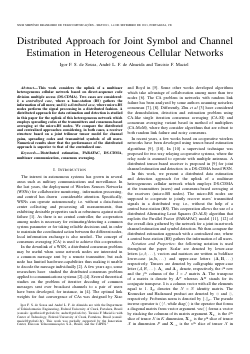
Distributed Approach for Joint Symbol and Channel Estimation in Heterogeneous Cellular Networks
Igor F. S. de Sousa, André L. F. de Almeida, Tarcisio F. Maciel
DOI: 10.14209/sbrt.2013.55
Keywords: Distributed estimation PARAFAC DS-CDMA multiuser communication consensus averaging
Abstract
This work considers the uplink of a multiuser heterogeneous cellular network based on direct-sequence code division multiple access (DS-CDMA). Two cases are considered: i) a centralized case, where a base-station (BS) gathers the information of all users; and ii) a distributed case, where micro-BS nodes perform the signal processing in a distributed fashion. A distributed approach for data estimation and detection is studied in this paper for the uplink of this heterogeneous network which employs spreading codes at the transmitters and consensus-based averaging at the micro-BS nodes. We compare the distributed and centralized approaches considering, in both cases, a receiver structure based on a joint trilinear tensor model for channel gains, spreading codes and transmitted symbols of all users. Numerical results show that the performance of the distributed approach is superior to that of the centralized one.Download
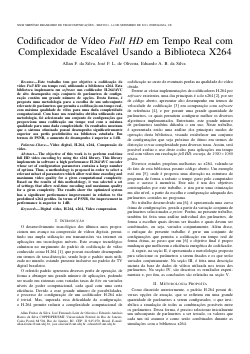
Codificador de Vídeo Full HD em Tempo Real com Complexidade Escalável Usando a Biblioteca X264
Allan F. da Silva, José F. L. de Oliveira, Eduardo A. B. da Silva
DOI: 10.14209/sbrt.2013.47
Keywords: Digital video H.264 x264 Video compression
Abstract
The objective of this work is to perform real-time full HD video encoding by using the x264 library. This library implements in software a high performance H.264/AVC encoder whose set of configuration parameters contains a large number of options. Thus, a methodology is proposed in order to select a relevant subset of parameters which allow real-time encoding and maximum video quality for a given computational complexity. Based on the results of this methodology, it was selected a set of settings that allow real-time encoding and maximum quality for a given complexity. The results show the optimized system has a significant performance improvement in relation to the predefined x264 profiles. In terms of PSNR, the improvement in performance is superior to 1 dB.Download
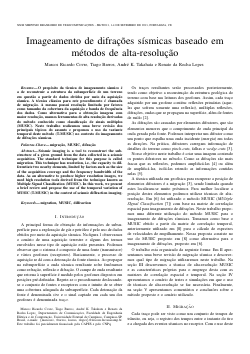
Imageamento de difrações sísmicas baseado em métodos de alta-resolução
Marcos Ricardo Covre, Tiago Barros, André K. Takahata, Renato da Rocha Lopes
DOI: 10.14209/sbrt.2013.46
Keywords: migration MUSIC diffraction
Abstract
Seismic imaging is a tool to reconstruct the sub-structure of a given ground from the data collected in a seismic acquisition. The standard technique for this purpose is called migration. This technique has resolution, i.e., the capacity to differentiate two nearby elements, limited by factors such as the size of the acquisition coverage and the frequency bandwidth of the data. As an alternative to produce higher resolution images, we used high resolution tools derived from the technique known as Multiple Signal Classification (MUSIC). In this work, we present a brief review and propose the use of the temporal variation of MUSIC (T-MUSIC) in the context of seismic diffraction imaging.Download
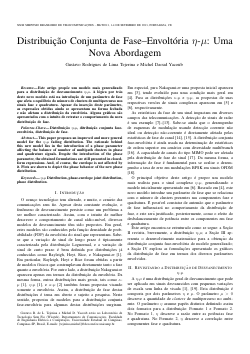
Distribuição Conjunta de Fase–Envoltória η-μ: Uma Nova Abordagem
Gustavo Rodrigues de Lima Tejerina, Michel Daoud Yacoub
DOI: 10.14209/sbrt.2013.61
Keywords: η-μ Distribution phase-envelope joint distribution phase distribution
Abstract
This paper proposes an improved and more general model for the η-μ fading distribution. The rationale behind this new model lies in the introduction of a phase parameter affecting the balance of number of multipath clusters in phase and quadrature signals. Despite the introduction of the phase parameter, the obtained formulations are still presented in closed-form expressions. And, of course, the envelope is not affected by it. Plots are shown to depict the phase behavior of the new phase distribution.Download
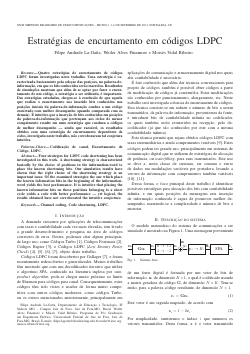
Estrategias de encurtamento em codigos LDPC
Filipe Andrade La-Gatta, Weiler Alves Finamore, Moisés Vidal Ribeiro.
DOI: 10.14209/sbrt.2013.67
Keywords: Channel coding Code shortening LDPC.
Abstract
Four strategies for LDPC code shortening has been investigated in this work. A shortening strategy is characterized basically by the choice of positions in the information-word to place the known shortening bits. Our simulation results have shown that the right choice of the shortening strategy is an important issue. Of the examined strategies the one which place the known information bits in the beginning of the informationword yields the best performance. It is intuitive that placing the known information bits on those positions belonging to a short cycle yields a code with better performance — yet logical, the results obtained have not corroborated the intuitive conjectureDownload

Algoritmo de estimação do azimute para alvos distribuídos em radares do tipo ArcSAR
Yusef Cáceres, Higor Cioqueta, Bruno Pompeo, Aleksander Medella
DOI: 10.14209/sbrt.2013.53
Keywords: Radar ArcSAR Estimation
Abstract
This article presents an algorithm to estimate a distributed target’s azimuth using an ArcSAR radar. This radar has transmitting and receiving antennas which rotate around a fixed axis with constant angular velocity, aiming a high nominal resolution in azimuth. In this scenario, this radar has two transmitting and receiving channels and uses this information to define a signal that does not present the target’s micro-Doppler effect. Then a matched filter is applied to estimate the target’s azimuth.Download

Estratégias de Transmissão para Sistemas MIMO com Canal de Realimentação Quantizado
Ândrei Camponogara, Renato Machado, Natanael Rodrigues Gomes
DOI: 10.14209/sbrt.2013.63
Keywords: Pre-coding wireless communication feedback channel
Abstract
This paper presents two transmission schemes for MIMO systems considering the use of a precoding at the transmitter. The precoders are updated at each new transmission frame and this updating is based on the feedback information. One transmission scheme uses the precoder for rotating the transmitted symbol phase, while the other one considers the precoder for power allocation at the transmitter. Results revel that the scheme which consider the power allocation at the transmitter presents a better performance than the one which considers phase rotation.Download
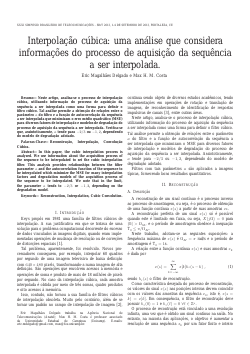
Interpolação cúbica: uma análise que considera informações do processo de aquisição da sequência a ser interpolada.
Eric Magalhães Delgado, Max H. M. Costa
DOI: 10.14209/sbrt.2013.64
Keywords: Reconstruction Interpolation Cubic Convolution
Abstract
In this paper, the cubic interpolation process is analyzed. We use information about the acquisition process of the sequence to be interpolated to set the cubic interpolation filter. This analysis provides relationships between the filter parameter a and the autocorrelation function of the sequence to be interpolated which minimize the MSE for many interpolation factors and degradation models of the acquisition process of the sequence to be interpolated. We note that in the limit, the parameter a tends to −2/3 or −1, 2, depending on the degradation model.Download